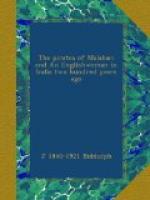Bourbon was a French possession, but the Governor, M. Desforges, was obliged to observe une grande circonspection in his dealings with the pirates who came and went as they pleased. Bernardin de St. Pierre, who visited Bourbon nearly fifty years later, repeats a tradition, how La Buze sat at table between the Viceroy and the Governor, and in an access of generosity remitted the Viceroy’s ransom. He further tells us that La Buze eventually settled down in the island, and was hung some years later.
Taylor, continuing his cruise in the Cassandra, took a fine Ostend ship, and carried her to St. Mary’s. While most of the pirates were on shore, the prisoners overpowered the few left to guard them, and carried off the ship. We get a last glimpse of the Cassandra in a private letter written to the Directors in May, 1723, from Jamaica, in which it is stated that the Cassandra was lying at Portobello, while Taylor was engaged in negotiating with the captain of an English man-of-war for a pardon. The negotiations apparently fell through, as Taylor was eventually given a commission by the Spaniards. The letter relates how the crew boasted that they had, each man, twelve hundred pounds in gold and silver, besides a great store of diamonds and many rich goods. Of the sharing of these diamonds, Johnson tells a story how one man, being given for his share one big diamond instead of a number of small ones, broke it up with a hammer, so that he might have as many ‘sparks’ as the others.
Macrae’s defence of the Cassandra, and the boldness and ability he displayed in his dealings with the pirates, brought him into prominent notice. The son of a poor Ayrshire cottager, he had worked himself up, from before the mast, to the command of a ship. Soon after his return to England, the Directors appointed him to be their supervisor on the west coast of Sumatra, and, before he sailed, a provisional commission was given him to succeed to the Presidentship of Madras, on a vacancy occurring. Eighteen months later, he took his seat as Governor at Fort St. George. His six years of office were distinguished by his efforts to put an end to many abuses that had grown up in the Company’s affairs. He left India with a fortune of L100,000, made by private trade, and settled down near his birthplace, which he had not revisited since he left it as a boy. He died in 1746.
NOTE.—The account of England’s cruise
in the Cassandra, given in
Johnson’s “History
of the Pirates,” is evidently taken from Lazenby’s
narrative to the E.I.C.
Directors. Macrae’s account of the capture
of
the Cassandra, given
by Johnson, appears also to have been part of a
similar report to the Directors,
but the report itself has disappeared.
Additional information is
to be found in the logs of the Greenwich
and London.
[1] Proclamation issued at Goa, 19th July, 1720 (Danvers).




